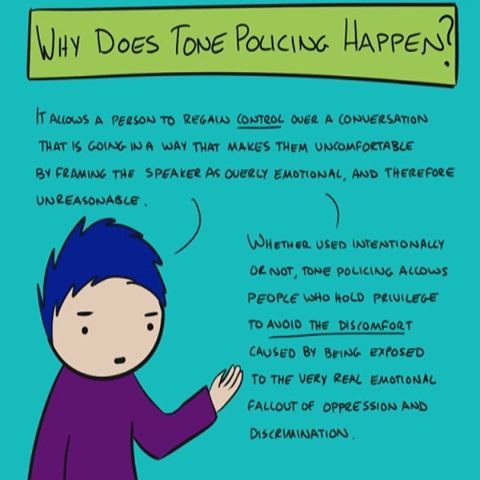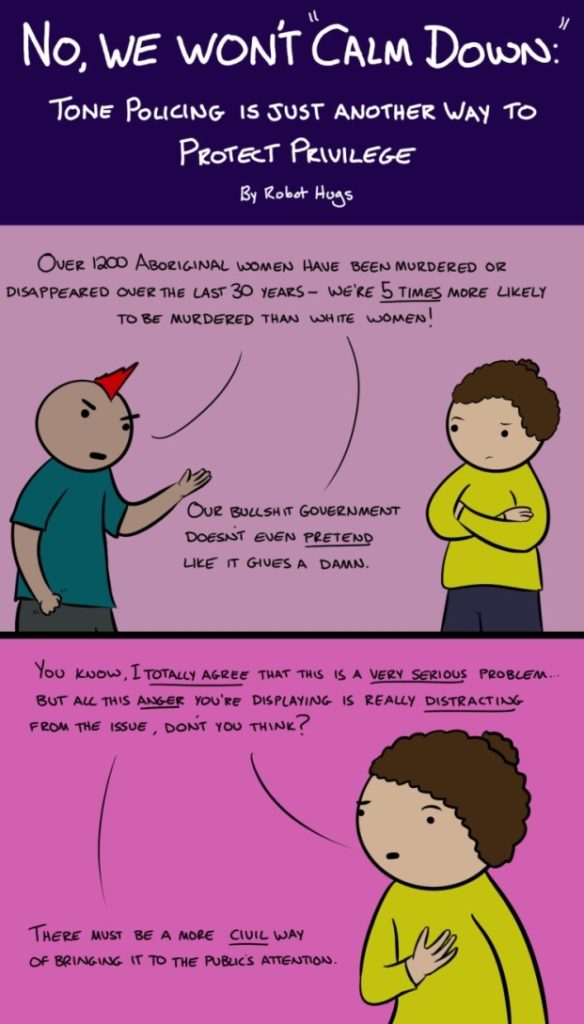Do you have anti-racist vocabulary terms and tips you’d like to share? Submit here
WHAT IS TONE POLICING?
Tone policing shows up in different situations by people holding privilege. It is used to prevent marginalized individuals or groups (racial/cultural minoritized persons, women, senior citizens, persons with special needs, LGBTQIA+ persons, persons living in poverty, etc.) from sharing their experiences of oppression. In this post, we focus on People of Color.
- Tone Policing is a silence tactic.
- Tone Policing reinforces white supremacist norms of how People of Color show up.
WHY DOES TONE POLICING HAPPEN?
- Tone Policing allows an individual(s) to regain control.
- Tone Policing is a method of persuading People of Color that they need to change.
- Tone Policing is a way of gaslighting – a form of psychological manipulation that seeks to sow seeds of doubt in Persons of Color by making them question their own memory perception or sanity.
EXAMPLES OF TONE POLICING
- Asking the Person of Color to calm down.
- Critiquing the emotion communicated by the Person of Color versus what is being communicated.
- Disagreeing that the Person of Color had the experience being communicated.
- Discounting the Person of Color’s experience as overreacting.
- Comparing the Person of Color’s experience to a non-tone policing experience you had.
- Requesting that the Person(s) of Color receive mentoring on how to communicate.
IMPACTS OF TONE POLICING
- People of Color silence their responses and do not share their experience, reducing the rich diversity of perspectives and perpetuating dominant narratives in the classroom and in the workplace.
- People of Color do not experience belonging and either transfer to other schools or find jobs elsewhere, impacting Stetson’s retention of students, staff and faculty.
- People of Color are not hired because their perspectives are too radical for the culture.
- People of Color are not considered for promotion.
- People of Color are mentored on how to communicate their lived experiences in the classroom and in the workplace, discounting the individual’s diverse contribution.
- People of Color are fired.
- People of Color are excluded from work and social opportunities/event because their lived experiences make others uncomfortable.
QUESTIONS TO CONSIDER
- How have I used tone policing out loud to silence, shut down, or dismiss People of Color? What kinds of words have I used to describe what tone a BIPOC (Black, Indigenous and People of Color) should use?
- What tone policing thoughts have I harbored when I’ve heard People of Color talk about race or their lived experiences, even if I didn’t say them out loud?
- How have I derailed conversations about race by focusing on how someone said something to me rather than what they said to you? Looking back now, why do I think the tone that was being used was more important to me than the content of the information being conveyed?
- How often have I made my willingness to engage in anti-racism work conditional on people using the “right” tone with me?
- How have you I discounted People of Color’s real pain over racism because the way they talk about it doesn’t fit with my world view of how people should talk?
- How have I discounted People of Color in general because of the tone they use when they talk?
WAYS TO MITIGATE TONE POLICING
When we understand how we tone police, we can begin to change our behavior to enable People of Color the full expression of their humanity.
- Use different language
- Listen to understand versus listen to react
- Bystander response
RESOURCES
Me and White Supremacy
Tone Policing: posted on January 15, 2016 by Robot Hugs
submitted by: Savannah-Jane Griffin, title, and Rosalie A. Richards, Ph.D., associate provost for faculty development and professor of chemistry and education
ABOUT THE ANTI-RACIST ACTIVISM SERIES
During AY2018-19, a group of faculty and staff met regularly as an informal affinity reading group for white people to develop their racial identities while simultaneously becoming more effective anti-racist allies for students and colleagues of color. The Anti-Racist White Affinity Ally Reading Group worked to identify and understand white privilege and how to engage in conversations around race so that they did not perpetuate racial injustice at Stetson.
The central goal of this anti-racist activism series is to capitalize on the affinity group’s activities to create shared understanding among our community. Shared understanding is not necessarily agreement. Rather, shared understanding offers our community common language to build an anti-racist vocabulary, offer a peek into the complexities of race, and contribute to our collective efforts in bringing about transformation in the ways that we do our work in the service of student learning.
Sponsored by the Office of Faculty Engagement at Stetson University





